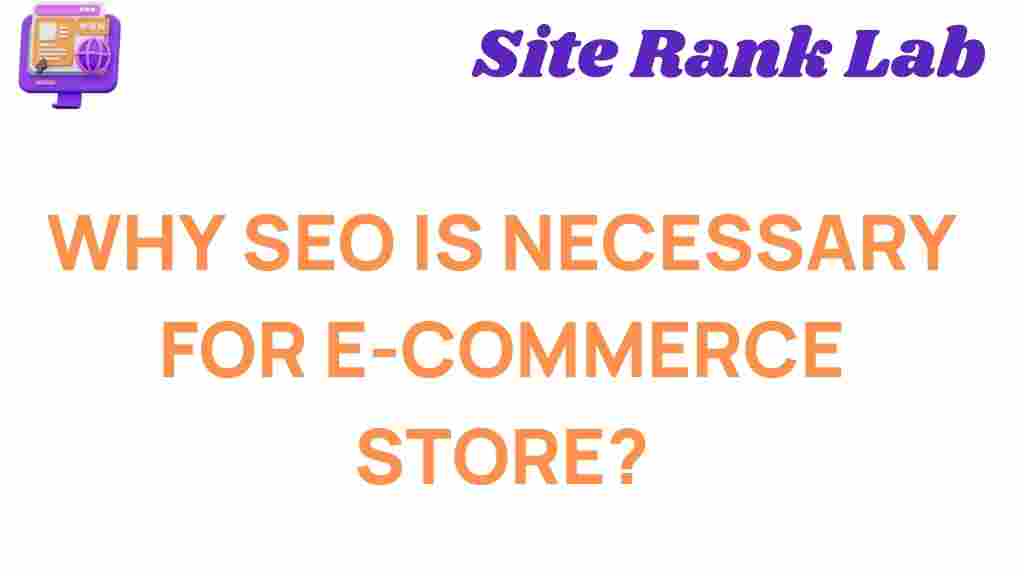Unveiling the Secrets: Why SEO is Essential for E-Commerce Success
In today’s digital age, the survival and growth of e-commerce businesses hinge on their ability to be visible online. With millions of online stores competing for attention, mastering SEO (Search Engine Optimization) has become a non-negotiable aspect of digital marketing. This article will unveil the secrets behind why SEO is essential for e-commerce success, focusing on key elements such as search visibility, website traffic, customer engagement, conversion rates, and achieving a competitive advantage.
Understanding the Importance of SEO in E-Commerce
The primary objective of any e-commerce website is to attract visitors and convert them into customers. Without a solid SEO strategy, your online store may remain hidden in the vast sea of the internet. Here are some reasons why SEO is crucial for your e-commerce business:
- Increased Search Visibility: Effective SEO practices improve your website’s visibility on search engines, making it easier for potential customers to find you.
- Higher Website Traffic: By optimizing your site for relevant keywords, you can drive organic traffic, which is often more valuable than paid traffic.
- Better Customer Engagement: A well-optimized site enhances user experience, leading to improved engagement and lower bounce rates.
- Improved Conversion Rates: With targeted traffic and enhanced user experience, your chances of converting visitors into paying customers increase significantly.
- Competitive Advantage: A strong SEO strategy helps you stay ahead of your competitors by ranking higher in search results.
Step-by-Step SEO Strategy for E-Commerce Success
To harness the power of SEO for your e-commerce store, follow this comprehensive step-by-step strategy:
1. Keyword Research
Keyword research is the foundation of any successful SEO strategy. Start by identifying the keywords and phrases that your target audience uses when searching for products similar to yours. Use tools like:
Focus on long-tail keywords that have lower competition but high intent, as these can drive qualified traffic to your online store.
2. On-Page Optimization
Once you’ve identified your keywords, it’s time to implement them into your website. Here are key areas to focus on:
- Title Tags: Include primary keywords in your product and page titles.
- Meta Descriptions: Write compelling descriptions that include keywords and encourage clicks.
- Header Tags: Use
<h1>to<h6>tags strategically to structure your content. - Product Descriptions: Write unique and detailed descriptions featuring keywords naturally.
- Image Optimization: Use descriptive file names and alt text for images, enhancing accessibility and searchability.
3. Technical SEO
Technical aspects of SEO are crucial for ensuring your site is crawlable and user-friendly:
- Site Speed: Optimize images and reduce server response times to improve loading speeds.
- Mobile Optimization: Ensure your online store is mobile-friendly, as a significant amount of traffic comes from mobile devices.
- Secure Sockets Layer (SSL): Use HTTPS to protect user data and build trust.
- XML Sitemap: Create and submit an XML sitemap to help search engines crawl your site effectively.
4. Content Marketing
Creating valuable content can significantly boost your SEO efforts. Consider:
- Blogging: Start a blog related to your products, providing valuable insights and tips.
- Video Content: Create videos showcasing your products or providing tutorials.
- User-Generated Content: Encourage customers to leave reviews and share their experiences.
5. Building Backlinks
Backlinks are crucial for enhancing your website’s authority. Focus on:
- Guest Blogging: Write articles for reputable blogs in your niche.
- Collaborations: Partner with influencers or other brands for promotions.
- Social Media Sharing: Promote your content on social media to increase visibility and links.
Troubleshooting Common SEO Issues
As you implement your SEO strategy, you may encounter some common issues. Here are troubleshooting tips for addressing them:
1. Low Search Rankings
If your website isn’t ranking well, consider the following:
- Reevaluate your keyword strategy. Are you targeting the right keywords?
- Check for technical issues like broken links or slow loading times.
- Improve on-page optimization by ensuring all elements are aligned with SEO best practices.
2. High Bounce Rate
A high bounce rate indicates that visitors are leaving your site quickly. To combat this:
- Improve page load speeds.
- Enhance user experience with better design and navigation.
- Ensure content is relevant to the keywords and search intent.
3. Low Conversion Rates
If you’re attracting traffic but not converting visitors into customers, consider:
- Optimizing your product pages with clear calls-to-action.
- Offering promotions or discounts.
- Improving trust signals such as customer reviews and testimonials.
Conclusion
In conclusion, mastering SEO is essential for the success of your e-commerce business. By enhancing search visibility, driving website traffic, fostering customer engagement, and improving conversion rates, you can secure a competitive advantage in the crowded online marketplace. As you embark on your digital marketing journey, remember that SEO is not a one-time task but an ongoing process that requires continuous learning and adaptation.
Implement the strategies discussed in this article, troubleshoot any issues that arise, and watch your online store flourish in the ever-evolving digital landscape.
For more tips on enhancing your SEO strategy, check out our comprehensive guide on digital marketing.
This article is in the category SEO and created by SiteRankLab Team
